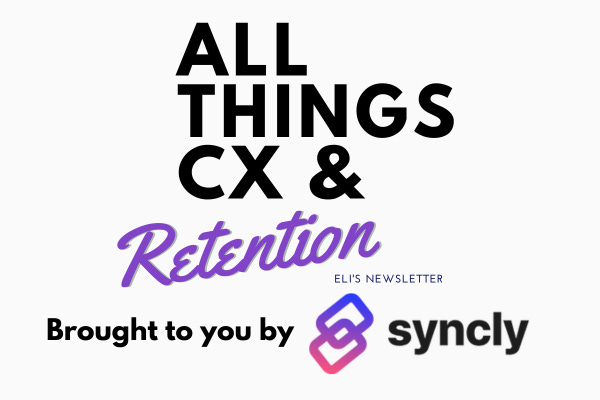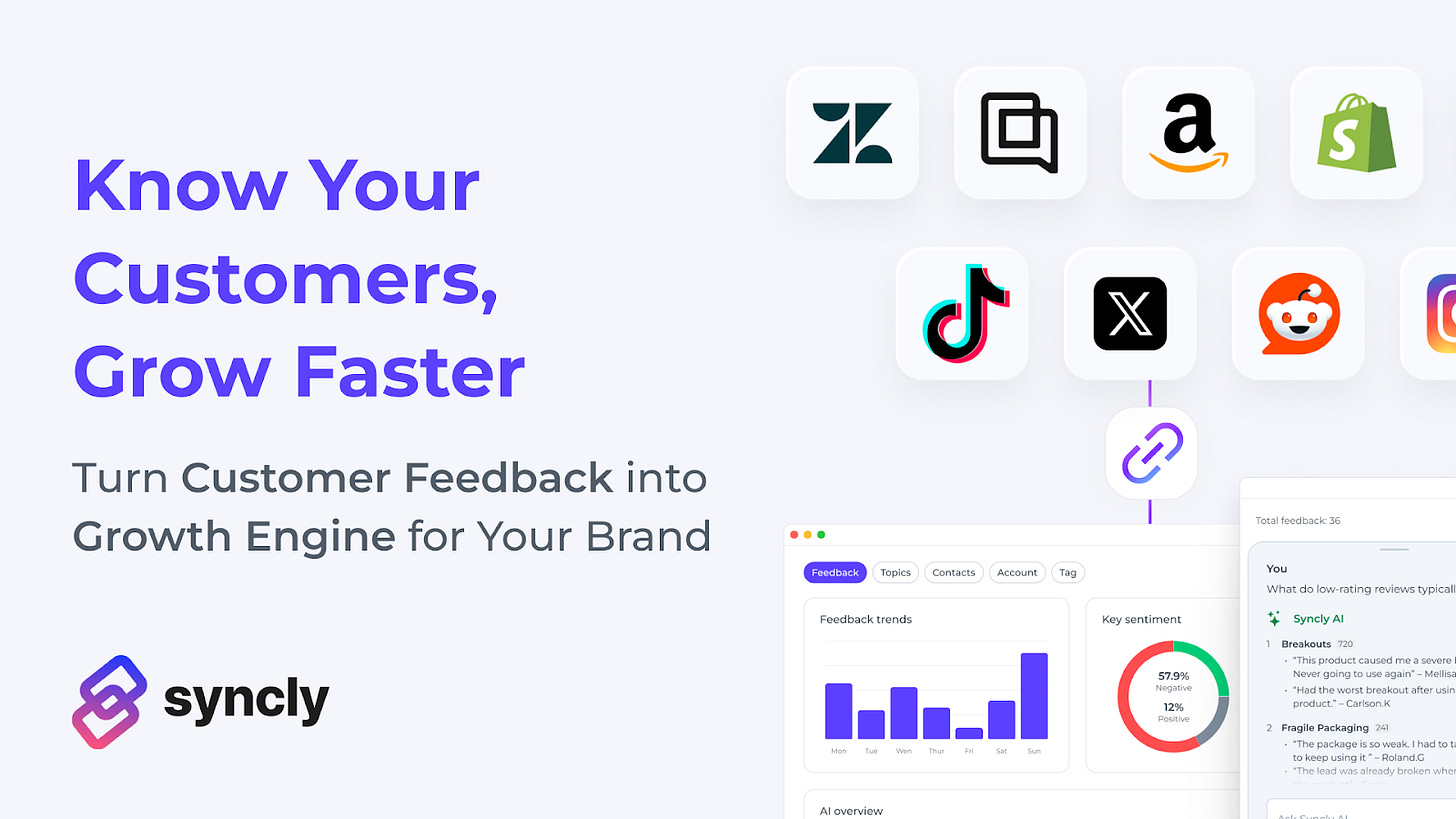90% Of Customer Feedback Is Useless
Unless you can use this system to turn some chaos into clarity
Hi Team!
Gosh, what a week. This summer is moving fast. Probably the most stressful one of my life.
My wife is deep in year one of residency. We have a four-year-old, a three-month-old, and I have a full-time job that is busier than ever. I’m trying to carve out even a sliver of space to feel something other than tired.
The house we just bought came with a “10-year-old roof,” which turned out to be 20+ and needs a full replacement. Noah is still adjusting to his first week of camp. I’m three cups of coffee in and it’s only 7 am.
But hey, Noah only gets one four-year-old summer. We’re squeezing every last drop out of it.
Now, back to work.
This week: How to turn ABSOLUTE customer chaos into clarity.
Most fast-growing brands end up in the same place. Feedback everywhere. Tickets piling up. Slack screenshots. Shared inboxes. Reviews, surveys, comments, DMs. Every team is drowning in noise but starving for signal or actionable insight.
The feedback is there. The insights are in there too. But without a system, chaos wins.
This week’s newsletter is about fixing that.
This week’s newsletter is brought to you by Syncly.
As your brand scales, customer feedback explodes. Are you building your strategy on the complete picture, or just the piece of it you can see?
Syncly helps brands digest customer feedback from multiple sources, including support tickets, product reviews, and social comments, to provide actionable insights that help brands grow faster.
With Syncly, you can:
See Everything in One Place: Unify all your customer feedback, including social channels, for a truly comprehensive view.
Organize Effortlessly: Use AI-powered auto-tagging to classify feedback into granular topics, so you know exactly what’s driving conversations.
Discover Insights with AI: Simply ask questions like you would with ChatGPT and get answers backed by real data and direct quotes from your customers.
Act on What Matters: Get real-time alerts and automated dashboards to take timely action on the most critical issues.
Neuro, a fast-growing functional gum and mints brand, uses Syncly to solve its feedback bottleneck and get every team aligned during its exponential growth phase, especially after their recent collaboration with Steve Aoki. >>Read their use case
From top brands like Kimberly-Clark and Brita (The Clorox Company) to fast-growing brands like Laura Geller and Buldak Ramen are also using Syncly to turn insights into action.
Want to see how Syncly helps brands scale their CX insights and streamline workflow?
Book a demo today to meet the founders and get a free demo.
Where It Breaks
Early on, feedback feels good. It means people care. You’re selling, you’re growing, and customers are paying enough attention to reach out. Every DM, every email, every review feels important, because in the early days, it is.
Someone on the team reads every message. You keep a spreadsheet. You forward screenshots to your co-founder. The CEO picks up the phone and calls customers during lunch, mostly so they can post about it on LinkedIn. You tweak the product because of one person’s comment in a Facebook group.
It works. Until it doesn’t.
Growth breaks this system.
The Feedback Flywheel
The brands that handle this well don’t have some secret playbook. They have a system.
Here’s how I think about it. A simple four-step process that turns feedback from chaos into clarity.
Centralize
Organize
Discover
Act
I’ll skip the fluff and explain each step.
1. Centralize
You cannot fix what you cannot see.
The first step is pulling everything into one place. Reviews, tickets, chats, social comments, survey data. It all needs to live in a single system. Feedback left floating in silos dies in silos.
Without some sort of central place, teams guess. Marketing sees one thing in social DMs. CX sees another thing in tickets. Product hears something else from their friend’s cousin. Decisions get made on incomplete data.
I remember being at a previous job and hearing the product team talking about overhauling a specific product because customers “hated x, y, and z.”
They were not wrong that customers had issues with the product. But the things she described were actually the only parts the customers liked. 🙃
In doing some digging, I learned it was a game of broken telephone that almost caused us to make an awful decision.
Centralizing feedback helps you make better decisions, faster. When you see the full picture, you can spot patterns early, prevent issues, and move ahead of competitors who are still piecing it together.
A central source of truth helps the entire business think and act together.
2. Organize
Once it’s centralized, the next problem shows up quickly. How do you actually make sense of it?
Manual tagging falls apart fast. One person says, “bug.” Another says “friction.” Definitions blur. Consistency disappears. You end up with a messy pile of opinions pretending to be data.
Automate it. AI or simple rules can handle the basics. Your team should not spend hours labeling tickets. Organizing feedback is not a real job.
The goal isn’t perfection. The goal is clarity. Clean, structured data helps your team stop sorting and start spotting what matters.
That is how you scale insight without adding people.
3. Discover
Organized data is just the beginning.
The real value comes from digging in. What’s trending. What’s changing. What is bubbling up that was not on the radar a month ago.
Look for signals. Topics with sudden spikes in volume. Categories pulling sentiment down. Connect the dots across teams to figure out what is really going on.
When the system is clean, this work gets easier. You can ask sharper questions and get answers that actually help. Not hypotheticals. Actual feedback from actual customers, tied to real outcomes.
This is the moment CX shifts from reactive to strategic. Patterns surface. Priorities get clearer. Teams stop guessing and start knowing.
4. Act
Insights are useless if they never leave the slide deck.
This is where most teams get stuck. They gather insights. They might even share them. But no one owns the work of turning those insights into action. Good ideas get lost in AI meeting notes.
Fix this by keeping it simple. Turn insights into reports people actually read. Assign ownership. Track progress. Close the loop with customers so they know you are listening.
The brands that win are the ones that move fast. Spot the problem. Solve it. Let people know it is fixed. Move on to the next one.
Acting on feedback is how you build trust. Customers do not expect perfection. They expect to be heard.
Building the Flywheel
When you repeat these steps, things start to shift.
Feedback stops feeling like a burden. It becomes a system that helps the business get smarter with every conversation.
Centralize. Organize. Discover. Act. Repeat.
Over time, this becomes a flywheel. Feedback comes in. Insights come out. Action gets taken. Customer experience improves. The cycle continues. The business moves faster and gets sharper with each turn.
This is how CX scales without chaos.
The inbox stops being a place where problems pile up. It becomes a place where patterns emerge.
The best CX teams are not the ones answering every ticket perfectly. They are the ones making sure the same issue does not show up twice.
That is the work. That is the leverage.
If this feels obvious, good. Most things worth doing usually are.
The hard part is doing it consistently.
That’s it for this week!
Any topics you'd like to see me cover in the future?
Just shoot me a DM or an email!
Cheers,
Eli 💛
P.S. If you want to figure out how to get your brand to rank high in LLMs and show up in ChatGPT, Gemini, and more… check this out.








